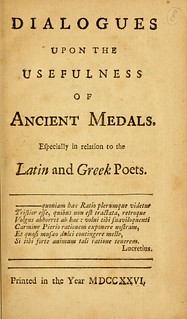
PREV ARTICLE
NEXT ARTICLE
FULL ISSUE
PREV FULL ISSUE
VOCABULARY TERM: MEDALDick Johnson submitted this entry from his Encyclopedia of Coin and Medal Terminology. Thanks. -Editor Medal. A memorial piece, of historic, commemorative, or artistic design, made in any of various ways – basically cast or struck – originally in the shape similar to a coin (but without denomination and certainly not intended to pass for money). In general, the word medal includes all forms of medallic items (except plaques); but also has a specific, numismatic definition: A medal is a round, or nearly so, medallic item between one and approximately three inches (25–80mm) diameter. Early use of term medal As all-encompasing a term as is "medals" – meaning almost everything medallic – the term originally meant even more. It once meant uncurrent coins as well, particularly those housed in collections. Undoubtedly this came from the early Low Latin word medalla which meant "a small coin."
Medal characteristics. Medals have a very wide appeal, both for their beauty, artistic design, topical subject matter and ability to present a portrait, but also for their historic value. Medals are the most ideal form of commemorating an event or person because of their permanence. We know of events from the past, where and when – and who was involved – because of medals. Medals can exist and pass on these pictorial elements and lettering to people in the future for thousands of years. Medals are the link between numismatics and virtually everyone in the world. They are the most coveted, distinctive way to honor a scientist, humanitarian or athlete. Every intelligent person in the world knows of the award ceremony of the Nobel Medal in Sweden, or the Olympic medals on the tri-tiered steps at the Olympic games. Medals can be created to honor the school child for excellence in studies, or the inventor of a lifesaving serum. Medals are permanent records of man's achievements, noble events, and personal accomplishments! Medals are also an ideal medium for portraits. The first use of the medal created by Pisanello in 1438 was to bear a portrait. Royal families took to medals for individual portraits and passed them to other royal families much like we send family photographs today. Of equal importance to the pictorial element on medals – its DEVICE – is its inscription, the lettering that names, explains, describes or amplifies the device. The obvious shortcoming of lettering is, of course, it has to be in a language that perhaps will not be in existence a thousand years from now. Can anyone read it then? Just as we observe two-thousand year old coins with inscriptions in a dead language, will the language we put on medals today be understandable in the distant future? Will scholars of the future study English as a forgotten, obsolete tongue? Yet we have no other choice. The chore rests with the medal designer, its creator. The goal is to design both device and inscription so attractive, so desirable, so enchanting, so appealing to be important enough to want to preserve it. Forever. Desired by both individuals and museums alike to want to posses it for the recall of its substance. To remember why it was issued. Medal Characteristics 1) Longevity (Long lasting).
I added the image of the Addison book's title page. You can read the complete book on the Internet Archive at the below link. -Editor To read the complete book, see:
Looking for the meaning of a numismatic word, or the description of a term? Try the Newman Numismatic Portal's Numismatic Dictionary at: https://nnp.wustl.edu/library/dictionary Or if you would like a printed copy of the complete Encyclopedia, it is available. There are 1,854 terms, on 678 pages, in The Encyclopedia of Coin and Medal Technology. Even running two a week would require more than 19 years to publish them all. If you would like an advance draft of this vital reference work it may be obtained from the author for your check of $50 sent postpaid. Dick Johnson, 139 Thompson Drive, Torrington, CT 06790. Wayne Homren, Editor The Numismatic Bibliomania Society is a non-profit organization promoting numismatic literature. See our web site at coinbooks.org. To submit items for publication in The E-Sylum, write to the Editor at this address: whomren@gmail.com To subscribe go to: https://my.binhost.com/lists/listinfo/esylum All Rights Reserved. NBS Home Page Contact the NBS webmaster 
|
